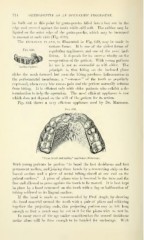Page 716 - My FlipBook
P. 716
714 ORTHODONTIA AS AN OPERATIVE PROCEDURE.
be built out at this ])()iut by gutta-])crcha filled iuto a box cut in the
edtj^e and ])ress('d at2:ainst the tooth while .still sof"t. Tiie rubber may be
ligated on the outer edue of the gutta-percha, which may be increased
in amount at each visit (Fig. 639).
The I^X'LINED pi.anp:, as illustrated in Fig. 640, may be made in
various forms. It is on(» of the oldest forms of
Fig. 640.
regulating appliances, and one of the most inef-
ficient. It depends for its success wholly on the
co-operation of the patient. With young })atients
its use is not as successful as with older. The
principle is, that biting on the inclined plane
slides the tooth forward, but soon the biting produces inflammation in
the pericemental membrane, a " soreness " of the tooth as pojmlarly
expressed, when every bite causes pain and the patient naturally refrains
from biting. It is efficient only with older patients who exhibit a de-
termination to help the operation. The most efficient appliance is one
which does not depend on the will of the patient for its action.
Fig. 641 shows a very efficient appliance used by Dr. Matteson.
Fig. 641.
"Tube, band, and spring" appliance (Matteson).
With young patients he prefers " to band the first deciduous and first
permanent molars, and joining these bands by a connecting strip on the
buccal surface and a piece of metal tubing closed at one end on the
palatal surface." A piece of piano wire is inserted in the tube and the
free end allowed to press against the tooth to be moved. It is best kept
in place by a band cemented on the tooth with a lug or half-section of
tubing soldered to its lingual surface.
If the band is made as recommended by Prof. Angle, by drawing
the band material around the tooth with a pair of pliers and soldering
together the projecting ends, this projecting portion may be left long
enough so that a notch may be cut in it for the piano wire to rest in.
In many cases of the age under consideration the second deciduous
molar alone will be firm enough to be banded for anchorage. With


